Droplet Computing
June 22, 2015
Nearly everyone has one or two
computer diskettes at the bottom of a drawer, somewhere. The more veteran
scientists might even have a
5-1/4-inch floppy acting as a
bookmark in some
notebook. I admit to having a few
eight-inch diskettes that I keep as
mementos of my earliest
computing days. These
media have one thing in common, they're
magnetic. Another thing they have in common is that
they're unreadable by today's computers.
Magnetic bubble memory is an obsolete magnetic media. This was an important
memory technology of the late
1970s and early
1980s, and it was my first
industrial research topic. The
logical bits of magnetic bubble memory were
magnetic regions in
garnet thin films. They were called "
bubbles," since they looked like bubbles through a
polarizing microscope.
In actuality, magnetic bubbles aren't bubbles; rather, they are
cylindrical magnetic domains. Unlike computer discs, magnetic bubble memory was non-mechanical, so it was far faster than disks and more
reliable. In the mid-1980s,
semiconductor memory technology advanced in speed and
density beyond magnetic bubble memory, so I moved on to other
research.
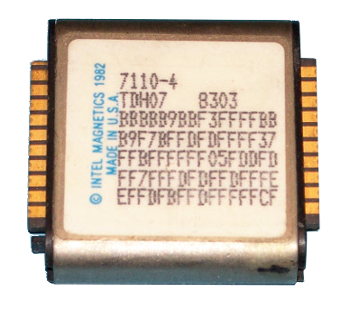
Photograph of an Intel Magnetics magnetic bubble memory module (c. 1982)
This module contains the thin film bubble medium, and two orthogonal coils that served to cycle the bubbles in storage tracks.
(Photo by the author, via Wikimedia Commons.)
As I explained in an
earlier article (Droplet Logic, September 19, 2012), magnetic bubble memories were
serial memory devices. The magnetic bubbles were shuttled around the magnetic film using an in-plane rotating magnetic field, provided by orthogonal coils. They were held captive on a pattern of a magnetic alloy. The operation of a T-bar pattern and an asymmetric chevron pattern are shown in the figure.
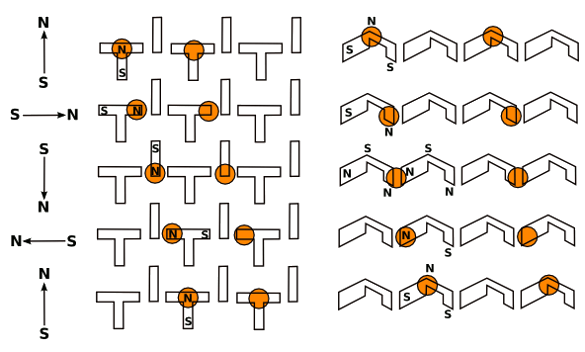
Two magnetic bubble circuits, the T-bar (left) and asymmetric chevron (right). The deposited permalloy pattern is magnetized in different states by an in-plane rotating magnetic field, and the bubbles are drawn towards the north-most pole. Diagram by author, rendered using Inkscape. (Click for larger image)
Just as bar magnets will repel each other when their magnetic vectors (N-S directions) are aligned, magnetic bubbles will repel each other. A magnetic bubble running along a track can be diverted onto another track by the presence of another bubble. The repulsion of proximate magnetic bubbles can be used to make some simple logic gates.
As we fast-forward three decades, a team of
engineers from
Stanford University (Stanford, California) has resurrected the bubble memory concept, this time using "real" bubbles. Their bubbles are droplets of a magnetic
fluid contained in a non-magnetic
liquid, and they are shuttled around similar magnetic patterns. Their research is published in a recent issue of
Nature Physics.[1-3]
It's possible to manipulate droplets using
electric,
optical, and
acoustic forces, also. Several years ago, a team of
Finnish and
Swedish scientists used
gravity to propel
water droplets along superhydrophobic channels so that they could interact to produce logic functions and a flip-flop.[4] The Stanford magnetic droplets are ferrofluid, and they run on
permalloy tracks.[1]
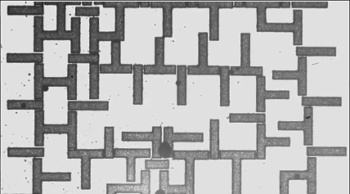
A ferrofluid droplet being guided along a permalloy T-bar track containing a logic pattern.
(Still image from a YouTube Video.)[3)]
Unlike magnetic bubbles in garnet materials, these ferrofluid droplets in another liquid medium are under the influence of more than just magnetic forces, since
hydrodynamics is involved.
Manu Prakash, an
assistant professor of
bioengineering at Stanford, who directed this research project, says that the
dissipative forces of hydrodynamics at low
Reynolds number are important to the operation of these devices.[5] The research team was able to utilize the interplay of magnetic and hydrodynamic forces between droplets to develop
AND,
OR,
XOR,
NOT, and
NAND logic gates, a
full adder, a
flip-flop, and a
finite-state machine.[1]
In the
laboratory experiments, the droplets were in the range of 0.3 - 1.0
millimeter, with a preferred value of about 0.6 mm, but the droplet size can be smaller.[1-2] The ferrofluid droplets were
water-based, and the carrier medium was
oil-based. The
parallel glass surfaces containing the media were coated with
Teflon.[1] Says
graduate student and
paper co-author,
Jim Cybulski,
"We can keep making it smaller and smaller so that it can do more operations per time, so that it can work with smaller droplet sizes and do more number of operations on a chip... That lends itself very well to a variety of applications."[2]
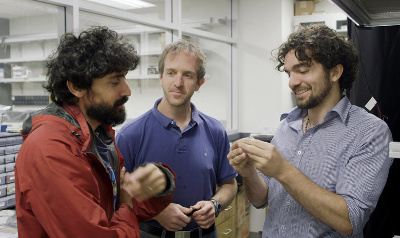
Manu Prakash, left, and graduate students Jim Cybulski and Georgios Katsikis, developers of the droplet computer.
(Stanford University photo by Kurt Hickman.)
As shown by the diverse number of logic functions demonstrated, these droplet circuits can do the same operations as a conventional electronic computer, albeit at a much slower rate. As graduate student and first author on the paper,
Georgios "Yorgos" Katsikis, explains, "Give us any
Boolean logic circuit in the world, and we can build it with these little magnetic droplets moving around."[2]
computation, itself, is not the target for this device. As Prakash explains,
"We already have digital computers to process information. Our goal is not to compete with electronic computers or to operate word processors on this... Our goal is to build a completely new class of computers that can precisely control and manipulate physical matter. Imagine if when you run a set of computations that not only information is processed but physical matter is algorithmically manipulated as well. We have just made this possible at the mesoscale."[2]
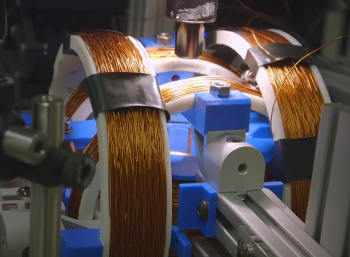
The orthogonal coils used to generate the rotating magnetic field in the experiments.
Just as for the magnetic bubble device in the first figure, these can be shrunk in size.
(Still image from a YouTube Video.)[3)]
The ability to computationally control the flow of small droplets of reagents might be useful for
high-throughput chemistry and
medical diagnostics.[2] The Stanford team plans to create a
design tool for such droplet circuits to allow other research groups to build on their experience.[2] Says Prakash,
"We are trying to build a new class of computers that not only manipulate information - but also manipulate physical matter simultaneously. Such an approach will make algorithmic assembly at mesoscale a reality."[5]
References:
- Georgios Katsikis, James S. Cybulski, and Manu Prakash, "Synchronous universal droplet logic and control," Nature Physics (advance online publication, June 8, 2015), doi:10.1038/nphys3341.
- Bjorn Carey, "Just add water: Stanford engineers develop a computer that operates on water droplets," Stanford Report, June 8, 2015.
- Stanford engineers build a water-droplet based computer that runs like clockwork, Stanford University YouTube Video by Kurt Hickman, June 5, 2015.
- Henrikki Mertaniemi, Robert Forchheimer, Olli Ikkala and Robin H. A. Ras, "Rebounding Droplet-Droplet Collisions on Superhydrophobic Surfaces: from the Phenomenon to Droplet Logic," Advanced Materials, vol. 24, no. 35 (2012), DOI: 10.1002/adma.201202980.
- Manu Prakash, Private Communication, June 10, 2015.
Permanent Link to this article
Linked Keywords: Floppy disk; computer diskette; scientist; 5-1/4-inch floppy; bookmark; notebook; 8-inch floppy disk; eight-inch diskette; souvenir; memento; computing; magnetic storage media; magnetic field; digital obsolescence; computer; magnetic bubble memory; magnetic storage; computer memory; technology; 1970s; 1980s; research and development; industrial research; Boolean algebra; logic; bit; magnetic domain; magnetic region; garnet; thin film; bubble; polarized light microscopy; polarizing microscope; cylinder; cylindrical; non-mechanical; reliable; semiconductor memory; clock rate; speed; number density; research; Intel Magnetics; orthogonality; orthogonal; solenoid; coil; Wikimedia Commons; serial; in-plane; rotating magnetic field; permalloy; magnetic alloy; asymmetry; asymmetric; chevron; magnetization; magnetized; Inkscape; bar magnet; magnetic vector; logic gate; decade; engineer; Stanford University (Stanford, California); fluid; liquid; Nature Physics; electric field; optics; optical; acoustic; force; Finland; Finnish; Sweden; Swedish; gravitation; gravity; water; droplet; superhydrophobe; superhydrophobic; flip-flop; ferrofluid; YouTube Video; fluid dynamics; hydrodynamics; Manu Prakash; assistant professor; biological engineering; bioengineering; dissipation; dissipative force; Reynolds number; AND gate; OR gate; XOR gate; inverter; NOT gate ; NAND gate; logic gate; full adder; finite-state machine; laboratory; experiment; millimeter; oil; parallel; glass; polytetrafluoroethylene; Teflon; postgraduate education; graduate student; scientific literature; paper; co-author; Jim Cybulski; Kurt Hickman; Georgios "Yorgos" Katsikis; logic circuit; computation; digital computer; information; word processor; matter; algorithm; algorithmically; mesoscopic physics; mesoscale; rotation; rotating; magnetic field; high-throughput screening; chemistry; medical diagnosis; medical diagnostics; computer-aided design; design tool.